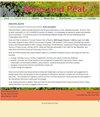Biogas and combustion potential of fresh reed canary grass grown on cutover peatland
IF 1.5
4区 环境科学与生态学
Q4 ENVIRONMENTAL SCIENCES
引用次数: 2
Abstract
(1) In Finland, in recent years, the combustion of dry reed canary grass (RCG, Phalaris arundinacea) grown intensively on cutover peatlands, has decreased markedly. We therefore made experiments in two areas to assess the alternative of using freshly harvested RCG grown for biogas production on cutover peatland. We measured both biogas production and combustion energy release. (2) The experiments show that the RCG biomass yields in total solids (TS) in both areas, with two cuts a year, were surprisingly small (yields of 2.7 and 4.2 Mg ha-1 [1 Mg ha-1 = 100 g m-2 ]); having biogas and combustion potentials, on the two areas, of 277–348 dm3 kg-1 VS (volatile solids) and 14.8–16.3 MJ kg-1 TS, and 11.8–21.9 MWh ha-1 in combustion. (3) Fresh RCG may produce larger biomass yields if cut several times a year, together with lower lignin proportion, and better suitability for biogas production compared with spring harvested dry RCG. (4) For cutover peatlands there are several after-use possibilities, however, with different benefits and challenges. For example, peat soil emissions may be affected during the after-use period, and this should be considered when planning the use of cutover peatlands.刈割泥炭地生长的新鲜芦苇金丝雀草的沼气和燃烧潜力
(1)近年来,芬兰刈割泥炭地上密集生长的干芦苇金丝雀草(Phalaris arundinacea)燃烧量明显减少。因此,我们在两个地区进行了实验,以评估在割地泥炭地上使用新鲜收获的RCG生产沼气的替代方案。我们测量了沼气产量和燃烧能量释放。(2)实验表明,在这两个地区,每年两次切割的RCG生物质总固体产量(TS)惊人地小(产量分别为2.7和4.2 Mg ha-1 [1 Mg ha-1 = 100 g m-2]);在两个区域的沼气和燃烧潜力为277-348 dm3 kg-1 VS(挥发性固体),14.8-16.3 MJ kg-1 TS, 11.8-21.9 MWh ha-1。(3)新鲜的RCG如果一年砍几次,可以产生更大的生物质产量,并且木质素比例较低,与春季收获的干燥RCG相比,更适合沼气生产。(4)对于割地泥炭地来说,利用后存在多种可能性,但带来的效益和挑战各不相同。例如,泥炭土的排放在使用后可能会受到影响,在规划割地泥炭地的使用时应考虑到这一点。
本文章由计算机程序翻译,如有差异,请以英文原文为准。
求助全文
约1分钟内获得全文
求助全文
来源期刊

Mires and Peat
ENVIRONMENTAL SCIENCES-
CiteScore
2.30
自引率
16.70%
发文量
0
审稿时长
33 weeks
期刊介绍:
Mires and Peat is a peer-reviewed internet journal focusing specifically on mires, peatlands and peat. As a truly “free-to-users” publication (i.e. NO CHARGES to authors OR readers), it is immediately accessible to readers and potential authors worldwide. It is published jointly by the International Peatland Society (IPS) and the International Mire Conservation Group (IMCG).
Mires and Peat is indexed by Thomson Reuters Web of Science (2017 Impact Factors: 1.326 [two-year] and 1.638 [five-year]), Elsevier Scopus, EBSCO Environment Complete, CABI Abstracts, CSA Proquest (including their Aquatic Science and Fisheries Abstracts ASFA, Ecology, Entomology, Animal Behavior, Aqualine and Pollution databases) and Directory of Open Access Journals (DOAJ). Mires and Peat also participates in the CABI Full Text Repository, and subscribes to the Portico E-journal Preservation Service (LTPA).
Mires and Peat publishes high-quality research papers on all aspects of peatland science, technology and wise use, including:
ecology, hydrology, survey, inventory, classification, functions and values of mires and peatlands;
scientific, economic and human aspects of the management of peatlands for agriculture, forestry, nature conservation, environmental protection, peat extraction, industrial development and other purposes;
biological, physical and chemical characteristics of peat; and
climate change and peatlands.
Short communications and review articles on these and related topics will also be considered; and suggestions for special issues of the Journal based on the proceedings of conferences, seminars, symposia and workshops will be welcomed. The submission of material by authors and from countries whose work would otherwise be inaccessible to the international community is particularly encouraged.
 求助内容:
求助内容: 应助结果提醒方式:
应助结果提醒方式:


